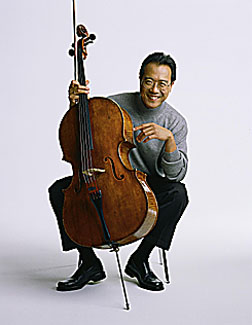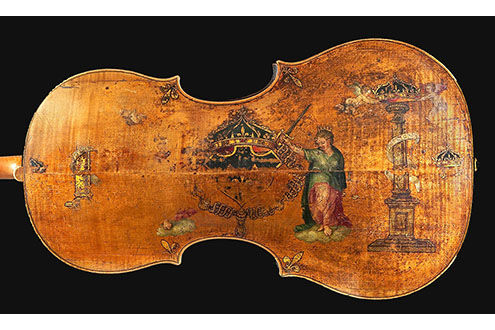By Andy Fein, luthier at Fein Violins,
and Ben Schuneman
and Ben Schuneman
Sometime in the year 1827, Luigi Tarisio acquired a violin from the late Count Cozio di Salabue and added it to his private collection. Both men were avid collectors of prized violins, and Salabue was well known for buying a large quantity of Stradivarius instruments.
The back of 'The Messiah' 1716 Stradivarius violin
In fact, the instrument was in such good repair and such high quality, that Tarisio would refuse to bring it out of his collection to show anyone, and instead just preferred to boast about it whenever given the chance. In fact, Tarisio was so well known for this perplexing habit, and he played the game for so long, that the famous French violinist Delphin Alard had joked, "Your violin is like the Messiah...One always waits for him, but he never appears!"
This prophetic comment would go down in history as providing the name for this secretive and hidden instrument, The Messiah. Now one of the most famous violins in history, The Messiah Violin sits in the Ashmolean museum in Oxford, England today.
The 'Messiah' at the Ashmolean Museum in Oxford
Following in the tradition of Tarisio, this instrument is so highly prized due to the fact that it has been rarely (if ever) played. The simple joke by a famous violinist had provided the name for the most prized violin in history, and yet, why is it that we find it necessary to name our instruments?
Even within the ranks of local and professional orchestras it is not uncommon to hear of someone who has a special pet name for their instrument. While working in the shop, I have been asked many times if I have named my violin, and traded stories with people about the best names that they have heard. This phenomenon has always intrigued me. After working the store for a couple of months now, I have come in contact with enough instruments and devoted players that I think I finally understand the answer.
From a strictly scientific standpoint, this action of naming inanimate objects is called anthropomorphism. It has been seen through many neurological studies that the same regions of the brain that are activated for thinking about human actions can also be activated while thinking about the actions and characteristics of non-human entities. What this implies is that the brain at some level is tricked into assigning human characteristics to inanimate things.
From a strictly scientific standpoint, this action of naming inanimate objects is called anthropomorphism. It has been seen through many neurological studies that the same regions of the brain that are activated for thinking about human actions can also be activated while thinking about the actions and characteristics of non-human entities. What this implies is that the brain at some level is tricked into assigning human characteristics to inanimate things.
Just understanding the basics, however, doesn't answer the question in my opinion. For any of us musicians it is easy to understand that each instrument is different. We can describe it with words like bright and dark, reactive, strong or weak, etc. But we all know how our own personal violin feels the most comfortable and feels the most like home. Each instrument does have its own personality. We feel compelled to name our instruments due to this fantastic variety in sound and personality of the tone. There are not two instruments that are alike.
While in the shop I have fallen in love with a specific instrument. It fits my style perfectly, and yet nobody else has wanted it as badly as I have or else it would be long gone. Its personality perfectly matches mine the same way the personalities of two best friends would match. It is a violin I am always happy to see and spend some time with while at the shop.
It is also due to the amount of time we spend with our instruments that leads us to supplying them with names. Anybody who is serious about learning the violin knows that it requires a phenomenal amount of time to learn it correctly. After spending so much time with such a unique and personalized musical tool, I find that it isn't surprising that we think of it as more than that.
While in the shop I have fallen in love with a specific instrument. It fits my style perfectly, and yet nobody else has wanted it as badly as I have or else it would be long gone. Its personality perfectly matches mine the same way the personalities of two best friends would match. It is a violin I am always happy to see and spend some time with while at the shop.
It is also due to the amount of time we spend with our instruments that leads us to supplying them with names. Anybody who is serious about learning the violin knows that it requires a phenomenal amount of time to learn it correctly. After spending so much time with such a unique and personalized musical tool, I find that it isn't surprising that we think of it as more than that.
Although a practice that I don't entirely understand, naming our instruments is something that many people are very fond of. I think it adds an extra level of intimacy to playing music than is naturally there.
Another phenomena is the naming of instruments after their famous players or owners. It's a fun diversion to see who is playing on whose past instrument.
Paganini called his violin 'Il Canone', the cannon, because, you guessed it, it was such a loud instrument.
Yo Yo Ma plays on a beautiful Montagnana cello nicknamed 'Petunia'.
The 'Circle' Stradivarius has a half circle in the upper bout of the back that was scratched in at the Stradivarius workshop. It seems that Stradivarius intended to have a coat of arms or other decoration in that area, but the decoration was never completed. The half circle remains.
The 'Wieniawski' Guarnerius del Gesu was played by the famous Polish violinist Henryk Wieniawski.
Bet you can't figure out who played the 'Ole Bull' Guarnerius del Gesu!
One of the oldest cellos in existence is 'The King' made by Andrea Amati circa 1538 for King Charles IX of France.
The 'Lady Blunt' Stradivarius violin recently set an outstanding record of sale at nearly sixteen million dollars. But who was Lady Blunt? ( No, my urban slang friends, it's not a hollowed out small size cigar.) Lady Anne Blunt was the granddaughter of Lord Byron, a member of the British aristocracy, and a pupil of the Czech violinist Leopold Jansa. If you're also interested in Arabian horses, the Crabbet Arabians are another part of her legacy.
There are so many more named instruments. Following the provenance of an instrument's name can give you a fascinating insight into who played it, where it was played, and how it was passed on to the next player.
Another phenomena is the naming of instruments after their famous players or owners. It's a fun diversion to see who is playing on whose past instrument.
 |
| Paganini's 'Il Canone' 1742 Guarnerius del Gesu |
Yo Yo Ma plays on a beautiful Montagnana cello nicknamed 'Petunia'.
 |
| Yo Yo Ma & 'Petunia' |
The 'Circle' Stradivarius has a half circle in the upper bout of the back that was scratched in at the Stradivarius workshop. It seems that Stradivarius intended to have a coat of arms or other decoration in that area, but the decoration was never completed. The half circle remains.
 |
| The 'Circle' Stradivarius |
The 'Wieniawski' Guarnerius del Gesu was played by the famous Polish violinist Henryk Wieniawski.
 |
| The 'Wieniawski' 1742 del Gesu violin |
Bet you can't figure out who played the 'Ole Bull' Guarnerius del Gesu!
 |
| The 1744 'Ole Bull' Guaneri del Gesu violin |
One of the oldest cellos in existence is 'The King' made by Andrea Amati circa 1538 for King Charles IX of France.
 |
| 'The King' image from The Met |
 |
| The 'Lady Blunt' 1721 Stradivarius |
There are so many more named instruments. Following the provenance of an instrument's name can give you a fascinating insight into who played it, where it was played, and how it was passed on to the next player.
Are you a string musician or interested in becoming one? Take a look at our Fine Violins, Violas, and Cellos!


The Ashmolean Museum is in Oxford, not London. This instrument was the only reason I went there and I was lucky enough to handle it once. Definitely Oxford.
ReplyDeleteYou are absolutely right Matt. Corrected!
DeleteI had the opportunity of "playing" the Circle Stradivarius back in 1976. At the time it belonged to Franz Bentler (sp) who had a group, that I believe, was called the "Royal Strings". At the time he entertained at the Continental Plaza in Chicago, where I also worked. One late evening he allowed me to hold which was such a thrill in itself. I had the nerve to ask him if I could play just one note and to my great surprise he said yes. I had played a violin when I was kid, but quit for rather obvious reasons--no talent. Franz showed me where to my finger to play, I think, a high "E" and it really sounded very good----but why shouldn't it have, it was a Stradivarius after all.
ReplyDelete